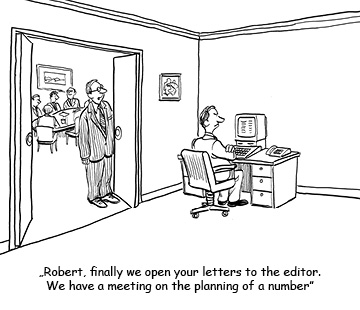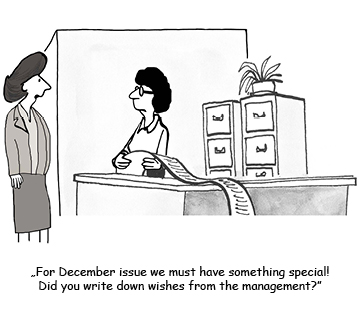
Editors from Aude – Magda Kozińska, who cooperates with “Oponowości” magazine published by Goodyear and Iwona Derda, editor of ING Bank Śląski “Baśka” and “Avon” magazines – surely know the answer to all the above questions.
Regular planning is essential for deciding on the content of the next issue of a magazine and for having a wide critical view on the publication’s role in internal communication. “It is a process of continuous improvement, perfecting and inventing,” says Magda Kozińska. Deciding on the content is not so much writing down a list of topics, but developing a personal attitude to them. It is absolutely necessary that representatives of a custom publishing agency are present during such meetings.

“In the planning stage, people from the communication department tell about what is happening in the bank, what are the current topics for the magazine. Our role is to spot certain things and explain how they can be best presented. I always do my best to listen and respond to what I hear. Our suggestion regarding what is right for ‘paper’ is based on our knowledge of paper magazines as a medium. It can’t be just regular information about what happened, because that’s what the Intranet is good for. It needs to have an added value – something that helps employees to develop, opens them to new issues, fosters their intellect,” Iwona explains.
We hit upon most ideas while we discuss something, often things not related to the business. It is during casual talks that we best realize how people perceive certain things – and communication is exactly about that: reaching the audience with your message. “You must think about an article with regard to the reader’s personal relation with the problem, which is strongest when we identify with the problem. That’s how the human brain works. For instance, if we take the subject of stress at work, I suggest that we show how stress impacts the human body and how it influences personal life. Similarly, we try to explain accurately and clearly the processes in the company – the goal is to make employees identify with what they do, what the company does, to make them think about their driving force. Otherwise, all we get is frustration,” Iwona adds.
Strategy, plans for the coming year – it is obvious that being part of an organization employees, readers, must be aware of them. For this reason most features for the magazine are determined by the key events in the company: current information campaign, strategy, important events – that’s what each issue lives with. But even when the communication department has already produced a few texts about a given project, it’s hardly ever catchy enough to be a ready-made article for the publication. “We carry out a lot of projects and programs in the bank which stand out in a given department. If we’re working on the next issue and I can see there is nothing spectacular there, it is my role to point to the topic with the greatest potential, even if it’s not visible at first sight. For instance, I can use various associations with the project slogan or the name of the project team. Sometimes one word is enough to come up with an idea for selling the subject. Naturally, we can do most with so called soft topics, but hard topics and projects can also be presented in an attractive way, if you maintain a healthy distance,” Iwona explains.
Magda adds: “Strategy, code of conduct and values are topics that should be best divided into separate elements – one value, a particular chosen issue. For instance, clarity or openness are values whose usefulness in everyday life can be noticed and described, or we can find a protagonist whose behavior is an expression of a given value (e.g. an employee who acts as a volunteer in a child care home).”

We don’t always need an existing campaign, because you can find corporate references in everything around you. If someone got injured in the factory recently, there you have it – the first important source of corporate topics, that is safety. “Each production facility has its own OSH rules. In theory they are boring, but only in theory, because you can translate them into various practical materials, e.g. in the form of infographics: a reminder showing where the extinguishers are, what to do in case of evacuation or fire,” Magda says.
Another area important for the company as well as for employees is health. In this case it is worth keeping in touch with the calendar of various diseases world days. Many of them relate to health problems connected to a particular business sector. “Such articles are easy to write because you have lots of materials and, what’s important, they are practical from the reader’s point of view. When it comes to health-related issues, the perfect situation is when we can talk to the company doctor, if there is one. You shouldn’t be afraid of going back to such topics, as each of them can be described from many different angles,” Magda suggests.
A topic that is often forgotten at the planning stage, but which is a tested source of ideas, is the compliance policy that every company has. “These ethical principles are easy to understand and refer to a typical day at work, e.g. what you musn’t do while using the company phone or car or why you can’t make a copy of encyclopaedia on the company xero machine…” Magda explains.
And if there is really nothing to write about? Magda has a ready answer: “If during the planning stage someone says they have absolutely no idea for an article, one of the most reliable topics in each company is savoir-vivre and interpersonal skills, e.g. how to act in case of a conflict or negotiations with the boss. It seems obvious, but people tend to forget about it. It’s also worth referring to the issues currently present in the media – you can treat such events as a pretext for writing an article. For instance, the Trump – Clinton debate is a pretext for writing about eristic (the skill of disputing) or the so called ‘Durczok case’ – mobbing at work. We use the media resonance of a given topic and choose a catchy headline.
 Finally, there is some place in corporate publications for a tabloid-type attitude. “We assume that the magazine should be reader-friendly, so we write about something that could be of interest to them from the human point of view, e.g. how to decorate home for Christmas. Such information is easy to find in commercial magazines, but it is a good ‘image warmer’ for a company magazine (naturally, not for all of them). This is the way to tell your readers: we think about you not only as employees, but also as people with their needs and feelings,” Iwona adds.
Finally, there is some place in corporate publications for a tabloid-type attitude. “We assume that the magazine should be reader-friendly, so we write about something that could be of interest to them from the human point of view, e.g. how to decorate home for Christmas. Such information is easy to find in commercial magazines, but it is a good ‘image warmer’ for a company magazine (naturally, not for all of them). This is the way to tell your readers: we think about you not only as employees, but also as people with their needs and feelings,” Iwona adds.
a) Direct talks
True journalist’s work for a magazine means finding out what is happening inside an organization and what is not mentioned by the strategic news produced by the head office. How do you search for a topic in a production company? Well, you won’t be able to do it from behind your desk – you need to put on a protective helmet, an apron, and meet the factory workers. This is how you can come up with an idea for an interesting coverage. “Most importantly, instead of talking to the manager on the phone, communication specialists should go and talk to people face to face. It doesn’t matter whether it is a production facility, a bank or a helpline,” Magda emphasizes. It’s not about investigative journalism but about building relations. Topics should be collected during everyday contacts. You should get interested in people – also those we don’t work with on a regular basis – and talk to them.

This role, however, is rather not for managers. The closer you are to a regular employee in a company hierarchy the better – e.g. a factory director’s assistant. In front of someone who doesn’t rate you as an employee, you can speak more freely and not be afraid whether you’re eloquent enough. “It’s easiest when topics are gathered by an external agency, because people working at the factory are not shy as they would be in front of their boss or his representative. They don’t see interest in their work as an attempt to control them. As a result, it feels more natural to them to tell about their work to someone from outside the company,” Magda says.
b) Looking for protagonists: innovators and enthusiasts
Even one visit of an agency to a production facility is enough to bring many ideas for interesting topics. You can discover a protagonist for the next article: an innovator or someone with passion. Magda reveals some methods from her experience with “Oponowości”:
“It’s worth talking to people who are willing to talk, e.g. the ladies working at the main gate or in the cafeteria, who know what employees talk about, know their passions, know what they do after work. Whenever we go to collect materials in a production facility we always ask the boys: So, what’s the good news? At first, they usually say that nothing, really. But if they think for a moment they always start to remember various seemingly trivial things: Actually, we made this insert for the machine recently to make it work better… And if you start asking the right questions, they will tell you all about it.”
Employee-made innovations are a huge topic in production companies. “Such safety-related minor improvements are frequent in factories, e.g. someone puts a gasket somewhere or moves the trolley a little bit so that the employee has a shorter distance to cover, and takes 300 steps a day less each day, which is better for the spine, etc.” Magda continues.
Iwona adds: “At Avon there are innovations implemented each month. Production employees in this huge factory are full of ideas – each day they come up with new ways of improving their work, e.g. designing a special hand pad, improving the perfume bottling process, saving materials for packing. They submit their ideas to the adequate department and it turns out they invented something that facilitates work for everyone or allows to save materials on a large scale. The company has developed a system of incentives for employees submitting improvements. Once a year each department (area) chooses the best innovator among all the nominees. We show these employees in the magazine. It’s satisfying for them and motivating for others.
c) Opening up for employees’ ideas
It is also worth encouraging and allowing employees to submit topics. What platforms can be used for that?
What about the non-computerized?
Magda suggests one of the possible solutions: “Goodyear has placed boxes at the main gate where employees can insert their ideas for articles.”
Another solution is a note in the magazine encouraging readers to send ideas placed below a given article, especially if you have regular columns.
Kategorie: school of contentic, B2E